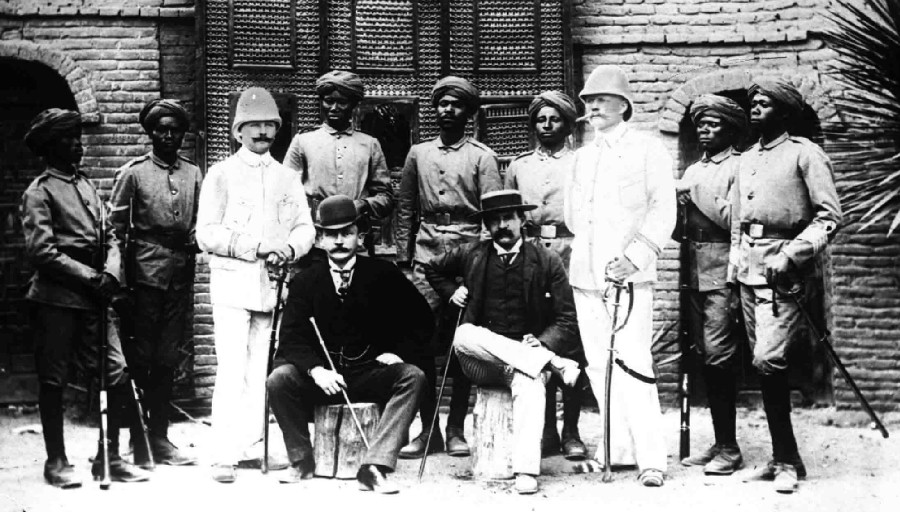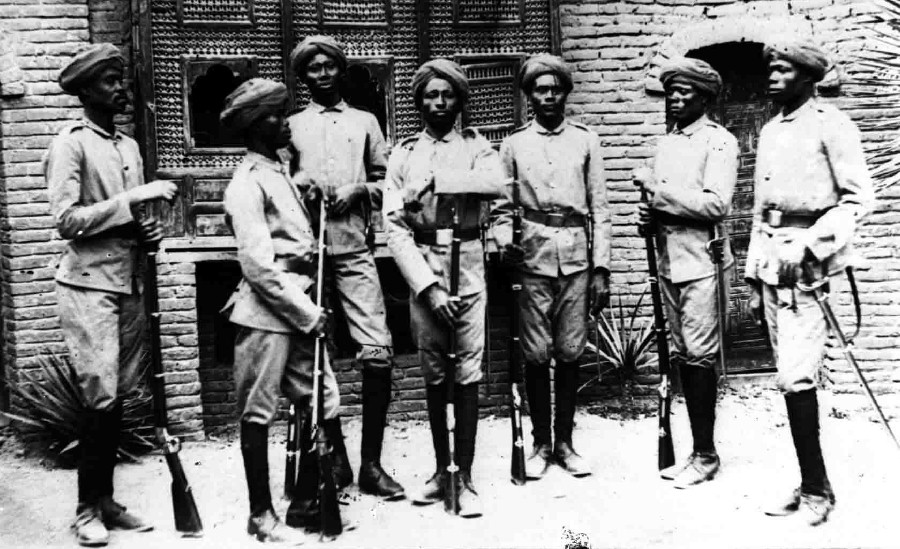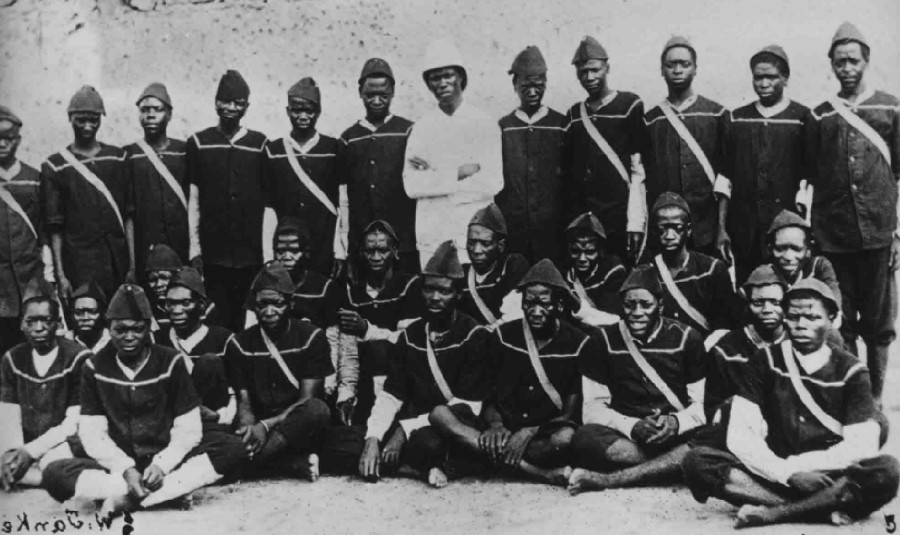|
The first East African askaris in
German service (those of the German East Africa Company and the
Wissmanntruppe) came from several different sources as did their
uniforms. Although uniforms were issued to most askaris not all were
dressed according to standards. One eyewitness
described some of the the Wissmanntruppe as, "(they) couldn't have looked less military, with
one man in a caftan, another in an Arab robe, yet another with the
remains of an earlier European uniform hanging off him, all in front
line service" (as quoted by R Schmidt in "German Schutztruppe
in East Africa 1889-1911" by E Nigmann, see
Book Reviews Page). By 1890
some form of uniformity was achieved when all askaris wore the khaki
uniform of the Sudanese troops (see
East African Askaris in the Early
1890s)
Swahili Askaris of the German East Africa
Company
In the late 1880s the German East
Africa Company had recruited a small number of Swahili askaris to protect their interests on the coast of German East
Africa. Upon the formation of the Wissmanntruppe these askari were
enrolled as the Swahili Company.
The Swahili askaris wore a short
sleeved white naval style uniform. It had a broad square naval
collar edged in the imperial colours. They wore matching white
trousers but no boots or puttees. Their headdress was a red fez with
a blue/black tassel.
| |
|
|
| |
Figure1 is based on a
photograph of a Swahili Askari NCO taken in about 1888.
During the late 1880's the German East Africa Trading Company
recruited a small number of askaris from the German colony to
protect their trading interests. They wore a white naval style
uniform as described above and seen here. These Swahili askaris were
then incorporated (with the same uniforms) into the Wissmanntruppe
in 1889. This askari wears NCO rank insignia in the from of a single
blue inverted chevron on the upper left arm and carries an
entrenching tool in addition to his large box ammunition pouch. Even
in the early German colonial campaigns, entrenching was an important
part of the siege warfare that evolved. This askari carries a Mauser
71 carbine. |
|
| |
|
|
Sudanese Askaris of the Wissmanntruppe
The Sudanese askaris still wore their old uniforms from previous
service in the Anglo-Egyptian army. The tunics were khaki with a stand a fall collar, plain shoulder straps,
plain cuffs, no pockets and five brass buttons fastening the front.
They wore matching khaki trousers and dark blue/grey puttees with
brown leather boots. Their headdress consisted of a red fez. Askaris
of the Anglo-Egyptian army had previously worn white cloths tied
around their fezzes as a form of cover from the sun. Photographs of
the askaris newly recruited into German service (and period
illustrations of them) show a grey turban wrapped around the fez. This turban
is illustrated by Knötel (see Illustrated
Plates Page) as having a brass imperial eagle on the front.
These Anglo-Egyptian khaki uniforms
became the basis of the standard design for all future uniforms of
the Schutztruppe askaris in German East Africa.
| |
|
|
| |
Figure 2 is based
on a photograph of a Sudanese Askari of the
Wissmanntruppe taken in Cairo, Egypt 1889 during their
recruitment by Leutnant Theremin. He
wears the Anglo-Egyptian khaki uniform with grey turban, dark/blue grey puttees and
brown boots as described above. This askari's turban does not seem to have
the brass imperial eagle on the front. It is possible that this was
a later addition to the uniform.
His equipment consists only of a
brown leather belt with a plain brass buckle. The Wissmanntruppe were supplied with the
Jägerbüchse 71 rifle but this askari
is still armed with his old Remington Rolling Block Rifle (Recommended
External Link -
Remington Rolling Block Page at
Military Surplus Guns) as previously used by the
Anglo-Egyptian army. It is not known if these rifles were still in
use by the time these askaris reached East Africa or whether they
had all been replaced by the Jägerbüchse 71.
This
askari also sports scarred cheeks, a traditional decoration among
certain Sudanese tribes. Such scars became the mark of the elite
Sudanese later in the Schutztruppe's history and were later sometimes
copied by non-Sudanese askaris.
Figure
3 is based on a photograph of a Sudanese Askari Effendi
(African Officer) of the
Wissmanntruppe taken in Cairo, 1889. He wears the same uniform
as the previous figure from the same photograph. His
rank as an officer is implied by his
carrying of a sword (Senior African NCOs in the Wissmanntruppe were
entitled to carry a sword like an officer would. By the 1890's this practice was
abandoned for askari NCOs) and his chevron cuff insignia the colours or
detail of which cannot be easily made out in the original
photograph, though they may be a remnant of French influence on the
Anglo-Egyptian army.
Likewise, any shoulder strap insignia
(if there was any) is also not clear in the original photograph upon
which this illustration is based. African officers, Effendis, in the
Wissmanntruppe usually wore from one to three five-pointed metal
stars on their shoulder straps (see
German East African Effendi Uniforms Page). Numbers of junior officers were recruited in Egypt
to accompany the Sudanese askaris. These officers were from the same
remnants of the Anglo-Egyptian army as the other ranks. As well as
Sudanese they included various nationalities from across the Ottoman
world such as Egypt, Turkey, Armenia and Greece. While these
officers were useful in the short term to help smooth the passage to
German service they were eventually deemed unnecessary and were
gradually phased out.

Photo ©
Frankfurt University Koloniales Bildarchiv
The photographs above and
below were taken in Cairo, Egypt in February 1889. They show
some of the first Sudanese askaris recruited from the
Anglo-Egyptian army.
The askaris wear the
Anglo-Egyptian army khaki uniform with grey turban,
dark/blue grey puttees and brown boots. Their equipment
consists only of a brown leather belt with a plain brass
buckle. They are armed with the Remington Rolling Block
Rifle from their former service. On the right of the
photograph is an Effendi (African Officer). His rank as an
officer is shown with looped chevrons on the cuffs. He
carries a sword rather than a rifle.
The German officers are
identified in the caption to the photograph as von Wissmann
and Oberleutnant Schaffer being seated in civilian clothes
and Hauptmann von Böhlau and Hauptmann B(?) standing behind
in uniform. Their ranks are presumably those from their home
units, as the Wissmanntruppe did not use the rank of
Oberleutnant or Hauptmann. Instead both officers show the
Wissmanntruppe rank of Leutnant with two band of lace in the
Imperial colours on each cuff.

Photo ©
Frankfurt University Koloniales Bildarchiv
|
|
| |
|
|
| |
|
|
Zulu Askaris of the Wissmanntruppe
The Ngoni Zulu askaris recruited in
Portuguese East Africa were issued a naval style uniform with a
square collar edged in the imperial colours very similar to
the Swahili askaris except in blue for parade and one of similar
design in khaki for active
service. Again they wore a red fez with blue/black tassel, trousers
matching their tunics and no boots or puttees.
A Danish planter,
Christian Lautherborn, made the following observations of the Zulu
Askaris: "The uniforms consisted of trousers with
short legs and shirts with short sleeves; this must have
been the most difficult type of work they had ever had. It
took more than an hour to learn how use these two pieces of
clothing. Some tried to use the shirt as trousers, others
the trousers as a shirt and some even carried shirts and
trousers back to front" (see full transcription
below). |
| |
|
|
| |
|
|
| |
Figure 4 is
based on a photograph of a Zulu Askari of the
Wissmanntruppe taken in about 1889. He wears the blue naval
style uniform worn by Zulu askaris of the Wissmanntruppe on parade.
Although it may have been worn in action on occasion it was usually
replaced on active service by a khaki uniform of similar cut. It has
the same square collar edged in the imperial colours as the Swahili
askaris white uniform but in period photographs, four buttons fastening the front can clearly
be made out. The red fez worn by this askari is of a more conical
shape than usually seen. The shape, height and style of fezzes
varied considerably. This askari also wears a white shirt under his
naval top.

Zulu Askaris of the
Wissmanntruppe c1889
Photo by
W. Janke
©
Frankfurt University Koloniales Bildarchiv
|
|
| |
|
|
Rank Insignia
Askari NCOs wore one to four inverted chevrons to display their
rank (see NCO Rank
Insignia Page). Wissmanntruppe askaris used Ottoman NCO titles,
another
tradition dating back to the previous service of many Sudanese askaris
in the Anglo-Egyptian army. Their
titles were- Ombasha/Gefrieter (with one stripe), Schausch/Unteroffizier (with
two stripes), Bet-Schausch/Sergeant (with three stripes) and
Sol/Feldwebel (with four stripes).
These chevrons were worn in blue on
the upper left arm, although little standardisation seems apparent
in period photographs with some NCOs wearing their chevrons on the
lower or right arms and some possibly using red chevrons as had the
Anglo-Egyptian army. In 1890 all chevrons were officially changed to
red.
Photographs of Sudanese askaris in
Cairo show one of them wearing some form of looped cuff lace to
indicate his rank. This may be a left over from earlier French
influence on the Anglo-Egyptian army.
Equipment
Personal equipment usually consisted
of a Prussian army large ammunition box at the front of a brown leather belt, sometimes worn with a
matching pouch at the back. Some Sudanese askaris not wearing the
central ammunition pouch can be seen in period photographs to be
wearing a plain brass oblong belt buckle (again probably the same
ones as used by the Anglo-Egyptian army). Askaris would also have carried water
bottles, bread bags and blankets, although I have no information as
to their sources.
Weapons
The majority of the Wissmanntruppe were
armed with the Jägerbüchse 71 rifle and the S71/84
bayonet. Photographs taken of the Sudanese askaris in Cairo
shortly after their recruitment show them still carrying their old
Remington Rolling Block rifles (and matching bayonets, similar to
the French Chassepot model) from the Anglo-Egyptian army and
some may have made their way to East Africa. Other askaris of this
period have been photographed with Mauser 71 carbines and older
obsolete firearms. Bayonet knots were not worn by askaris.
An Eyewitness Account of the Wissmanntruppe
Zulu Askaris and Their Uniforms
A Danish planter,
Christian Lautherborn (1), made the following observations of the
Zulu Askaris employed for service in German East Africa by Hermann
von Wissmann in a letter to his sister back in Denmark on 4th
July 1889 (2).
“Among Wissmann’s native soldiers, I am
most interested in the Zulus. When they arrived here they knew
absolutely nothing about being a soldier or Civilisation for that
matter. Their clothing was like our forefathers’ after the Fall of
Man, the only difference being that the Zulus have replaced the fig
leaves around the waist with a piece of nicely cut skin, with
fringes.
Their ears had large wholes which were
used to carry small, but vital items. In one ear they carried their
snuff inside a dry leaf, and in the other they had a toothbrush. Not
of the same type we civilized people use, but a short piece of a
green twig from some tough tree; one end was chewed up in fine
threads, almost like a paintbrush, and they use their toothbrushes
after each meal.
As for their long, almost wool-like
hair, they have plaited it with grass (similar to what we do when
plaiting a horse’s mane with straw), thus leaving the plaits
bristling in all directions, almost like the spines of a hedgehog.
We had the most fun when the Zulus
received their uniforms. The uniforms consisted of trousers with
short legs and shirts with short sleeves (3); this must have been
the most difficult type of work they had ever had. It took more than
an hour to learn how use these two pieces of clothing. Some tried to
use the shirt as trousers, others the trousers as a shirt and some
even carried shirts and trousers back to front.
When they finally were properly dressed,
they had to learn to wear the red caps, and this was almost as
difficult as learning to wear the uniform. It was almost impossible
to squeeze in their bristling plaits under the cap; and when they
finally succeeded, only a slight movement made the plaits come out
again, thus leaving the cap balancing on the top of the plaits for a
few seconds before it fell to the ground. However, they wanted to
look like the other native soldiers, so the next day they sat around
in the town, cutting off each others plaits.
The Zulus’ first time on the shooting
range was almost as funny; most of the men may have been used to
bows and arrows, but when aiming their rifles they were terrified of
what would happen when they pulled the trigger. This happened the
first day only, and now they are no worse than other native
soldiers.
Each day the Zulus get more civilized.
When they leave for guard duty, they have replaced the snuff and
toothbrushes in their ears with a cigar in one ear and a cartridge
in the other, because, as they say, taking a cartridge from the ear
is much quicker than taking it from the ammunition pouch, and if
Buschiri (4) should come by, they want to be ready.
By the way, the Zulus are very brave and
most ambitious. They say: ‘We may be savages and have never known
about soldiering, but it will not take long before we are as good as
the others,’ and they really do their best to learn, and over time
they will be fine soldiers.” (5)
(3) Uniforms- This
description fits perfectly with out knowledge of the Wissmanntruppe
Zulu Askari uniforms (as described at the top of this page), it
unfortunately does not mention whether these uniforms were blue or
khaki service dress.
(4) Abushiri ibn Salim al-Harthi (18..-1889), the leader of
the Abushiri Rebellion, otherwise known as the Arab Revolt
(1888-90).
(5) Other Reports of the Early
Zulu Recruits- The
observations seen here can be read as a supplement to those by
Hauptmann Georg Richelmann on the first drill exercises by the Zulus, as
referred to on P5 of "German
Schutztruppe in East Africa 1889-1911" by Ernst Nigmann (see
Book Reviews Page).
Special thanks for help
on this page is due to M Reid (and his colleagues at the
Gentlemen's Military Interest Club) for information on the
uniforms of the Anglo-Egyptian army, and to Per Finsted (of the
Chakoten Danish
Military History Website) for the Eyewitness Account of the
Wissmanntruppe Zulu Askaris.
Recommended External Links-
Abushiri and the Wissmanntruppe by
Rudy
Scott Nelson at the Heliograph.com
Die Wißmann-Truppe
by Horst Hübner at
Traditionsverband.de
Hermann von Wissmann by Thomas Morlang at Afrika-Hamburg.de
German Colonial Wars by Paul Beck at Savage and Soldier.com
Recommended Published Sources-
"German
Schutztruppe in East Africa 1889-1911" by Ernst Nigmann
translated by Robert E Dohrenwend (Published
by Battery Press)
"Die Kaiserliche Schutz- und Polizeitruppe für Afrika"
by Reinhard Schneider
(Published by Druffel & Vorwinkel-Verlag)
"The
German Colonial
Troops 1889-1918" by
Jürgen
Kraus and Thomas Müller (Published by
Verlag in English or German)
"Askari und Fitafita - Farbiger Söldner
in den deutschen Kolonien" by
Thomas Morlang
(Published by
CH Links)
"Die Deutsche Schutztruppe 1889/1918" by Werner Haupt
(Published by
Dörfler)
|